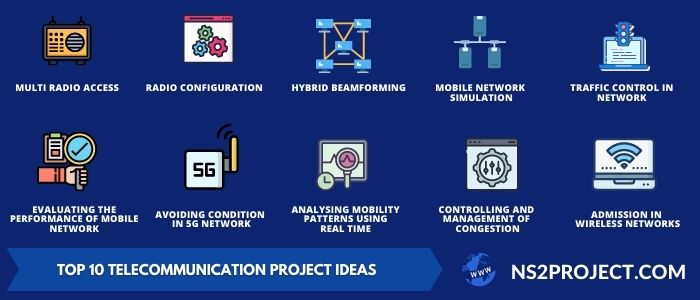Generally, a telecommunication network is a group of computational and networking resources used to send data to various destinations. A telecommunication network consists of network nodes connected by telecommunications links that allow for sending of information.
To transmit data and indications, the linkages could employ a variety of methods depending on circuit-switched networks, messages, or packet switching approaches. In this domain, managing algorithms and architectures had long been utilized in a wide range of information technology in traditional communication systems
“Through this article, you can get a complete picture on different telecommunication project ideas and their impact”.
A vast variety of innovative communication networks are regularly deployed by significant carriers. Their networks make use of technology such as listed below,
- Wireless and optical networks
- SONET and IP networks
- Cellular network
- Frame relay
- Microwave communication
- Optical Communication
- Satellite communication
The processes of managing flexibility are critical because they ensure that the expenditure of the service provider in monitoring systems is increasing and that greater services and networking functions of management may be performed. Let us first start with the important subjects in telecommunication.
What are the major subjects of telecommunications?
There are important telecommunication subjects that are actively taken up for study and research around the world.
- Wired
- Wireless
- Satellite telecommunication
As we have been guiding research telecommunication projects and finally here projects related to telecommunication for more than 15 years and we have gained immense experience in the field. So you can talk to our experts at any time in your project journey. Let us now justify the importance of our Telecommunication project guidance.
Usually, researchers look for an ultimate and comprehensive guidance facility that supports them in all aspects. In this regard, we provide your project assistance on the following basis,
Why to choose us for telecommunication projects?
- Evaluate and measure the network in great detail
- Prototype installation and testbed experiments
- Maximum performance assessment of simulation software studies
- Designing communication technologies by considering all characteristics
- Traffic analysis in cellular networks and estimation of evaluation criteria including QoE, QoS and user mobility
- Novel communication network modelling methodologies as well as their implementation using optimal simulators
- Innovative methods and forecast approaches for monitoring and controlling mobile networks
- Simulations of transmission behaviour in next-generation networks
- New simulator engines for telecommunications with network nodes are being developed
So you can totally rely on us for your entire research. We have got dedicated teams of experts for assisting you technically in project design and certified writers to guide you in writing aspects which includes thesis, proposal, paper publication, and many more. Read more about us at telecommunication project ideas. Let us now talk about the working of Telecommunication Networks
How does telecommunication works?
Telecommunication technology has evolved from the very early systems like semaphore telegraph, optical heliographs, smoke, and other signal flags
- The modern telecommunication methods have now advanced to wireless communication mechanisms using electromagnetic signals or wired using electric cables and even light.
- The part used for transmission is often called the communication channels
- Simultaneous multiplexing of various communication sessions is one of the greatest advantages of the modern-day communication channels
It is significant to know that telecommunication is represented in the plural form to notify the wide range of technologies it includes. If you are facing any issues regarding the working of your Telecommunication projects then you can readily reach out to us. We will instantly resolve all your queries and suggest the best-proven practices as solutions. Let us now understand the various telecommunication network components.
What are the components of Telecommunication?
- Network access terminals
- Computers for processing data
- Interconnected networks
- Channel links for telecommunication involved in data transmission
- Equipments and software for facilitating data transmission and controlling message transfer respectively
Advance development for being implemented to magnify the uses of these basic components of any telecommunication network mentioned above. Actually, we will provide you authentic references from top research journals and benchmark sources to give you a better hold on the topic. Let us now see the OSI telecommunication model aspects.
What are the layers of OSI model of Telecommunication?
- Host layers
- Application layer – network process to application
- Presentation layer – representation and encryption of data
- Session layer – communication among variety of hosts
- Transport layer – Reliability of segments and end to end connections
- Media layers
- Network layers – logical addressing and determination of paths
- Physical layers – transmitting signals, media and binary (bits)
- Data link layers – LLC and MAC physical addressing (frame data units)
As we have been in the field of Telecommunication research for the past two decades we are very much experienced in handling projects and solving issues associated with different layers as mentioned here. Now let us talk about the recent telecommunication network technologies.
5 Latest Technologies in Telecommunication Networks
The following technologies have impacted telecommunication networks and their functioning to a greater extent
- Artificial Intelligence
- Artificial intelligence (or AI) is being more widely used in telecommunication, with services like virtual assistants and bots for messaging (chatbots) that are used to enhance the customer experience
- Predictive analytics AI is extremely important for the network infrastructure because it enables easier operation and optimization
- Fifth generation mobile communication standards (or 5G networking)
- Installing, 5G would boost data throughput, allow networks slicing, and provide incredibly less latency and advantage of these advanced opportunities in data transmission, user interaction, and additional services as a result of 5G
- Big Data
- Telecommunications businesses would seek to purchase and generate ever-increasing amounts of data using mobile platforms, software, wearable, and radio data
- All of this data poses data security threats, and companies must address these concerns in order to comply with regulations
- Also it guarantees that user data is managed and transmitted with their full consent
- Distributed Ledger technology
- Distributed Ledger Technology (DLT) is a registration based on blockchain
- Other decentralized responsibilities, including the administration of security aspects as near the end users as feasible, are also part of this technology
- Internet of Things
- When the operators concentrate on IoT, they will be in a position to benefit substantially from a worldwide IoT
Since these technologies are newer, you shall reach out to us for any kind of technical assistance regarding them. Our technical team is here to give you full support for your project. The telecommunication project ideas are expanding every day due to the recent scientific breakthroughs. In this regard, the following are some of the important latest project ideas in telecommunication.
Latest Top 7 Telecommunication Project Ideas
- Multi radio access and radio configuration
- Hybrid beamforming and mobile network simulation
- Allocation of resources and traffic control in networks
- Predictive routing models and evaluating the performance of mobile networks (LTE QoS and QoE)
- Avoiding condition in 5G network environments and managing its mobility
- Analysing mobility patterns using real time and synthetic models
- Controlling and management of congestion and admission in wireless networks
Currently, we provide research support on all these telecommunication thesis topics. We are here to give you a complete idea of the various methods and approaches used in doing these projects. In this respect, let us now look into the different techniques used in telecommunication projects. The major techniques used for the implementation of Telecommunication project ideas are listed below
Techniques for Telecommunication projects
- Machine learning and deep learning methods
- Game theory, evolutionary algorithms and economic theory
- Queuing and probability theories, stochastic processes and Control theory
- Automated reasoning, mathematical optimisation and logic
Our technical teams have gained a lot of expertise in working with these Tools and techniques. We have also registered success in all projects delivered to date. Let us now see the various metrics used for evaluating the performance of Telecommunication network projects.
Generally speaking, choosing adequate or indeed optimal criteria is based on who would be using them. Various communication properties have different aims and needs. It also depends on timeframes, assessment site, preconceptions, modeling approach used, and situation investigated. In the designing, construction, installation, and administration of communication systems, metrics are becoming highly significant. Though they have huge relevance, metrics research is frequently confined to a certain sector or a specific goal.
In order to better comprehend the present measurements ecosystem, our study will take a broader look at the metrics which are regularly used for assessing, creating, and maintaining communication services.
Performance Metrics for telecommunication
The different metrics used for the evaluation of Telecommunication project ideas are listed below. So for selecting the appropriate metrics for evaluation you shall consider the following points,
- Accuracy of measurement (errors within the limits)
- Feasibility of data collection (for measurement)
- Efficient consumption of resources
- Viable collection of data for measurements
- Desirable measurement have to be collected for evaluating system designs and operations
- Robustness has to be maintained (alterations in the system and environment should not affect the quality of measurement)
- The correctness of simulation depends on how well the measurements are checked
Based on the above points and our findings through various research projects we consider the following as the important metrics to be used for telecommunication networks
- Efficiency in consumption of power and energy
- Metrics for network security
- Quality of service and quality of experience
- Fairness in resource allocation and resilience
- Robustness
Almost all of our projects have shown excellent results with respect to these parameters and metrics. With this track record of success, we will now listen to some of the important factors that affect the performance of Telecommunication networks.
Key factors that influence the performance of Telecommunication networks
On the basis of the experience that we gained, we have listed some important characteristics that impact network performance.
- Infrastructure and topology of the network – equipment, node level simulators and link
- Limitations of performance based on quality of service measurements
- Protocols used
- Mode of applications – standby, sleep, transmission and reception
- Load of the network – in null, half and full traffic
We also look at measurements for modern electronic systems like operating systems and Web Pages, measurements for internet traffic, and analytics for big data machine learning. Get in touch with our team of experts to successfully implement any telecommunication project ideas.









